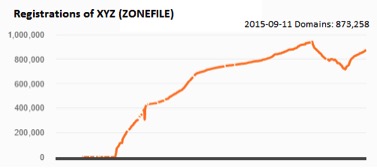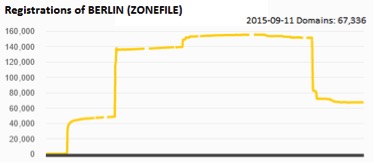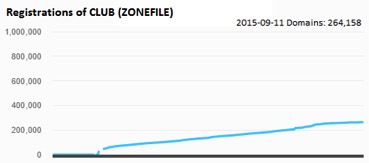Analyzing growth rates & business models
Nineteen months since new gTLDs were made available to the public, total registrations now exceed 7.3 million according to ntldstats.com while other registration stats tracking sites show 6.9 million. Why the 400,000 difference? Ntldstats.com uses the registration status of names based on WHOIS data while the others use zonefile totals as their authoritative base.
Difference between zonefile & WHOIS data
Eco’s gTLD Stats page is powered by TLDWatch which utilizes zonefile data. So, which is a better indicator? Both are insightful and many in the domain industry understand that total registrations whether based on zonefile data or WHOIS data are only one of many indicators that define success. No matter what success criteria might be used, total registration counts are the foundation for any analysis.
One difference to consider when reviewing stats based on WHOIS data is its Registration Status. While a domain name is still considered “Registered” via its WHOIS status especially after it has expired (and likely not to be renewed), at a certain point of the expiration phase in the registration life-cycle, the name is removed out of the zone and no longer resolves rendering it unusable. Therefore, it might be more important to view initial registration stats of names that resolve, because it begins to provide an indication that the name is used in one capacity or another in addition to being registered.
new gTLD growth in 2015 will exceed 2014
Now that new gTLDs are well into their second year, there is no doubt that 7.3 million total registrations have not met most expectations. Calendar year 1 (2014, 11 months of activity) closed out at 3.7 million names, while calendar year 2 (2015, 8 months of activity) is presently at 3.6 million names. Thus far, the calendar year growth rate from 2014 as compared to 2015 is nearly the same. The differences for 2015 is that four months remain in year 2, but 2015 has also experienced declines as expiration of 1st year registrations started to occur in May 2015. It is expected however that year 2 growth will exceed year 1.
With nearly 750 new gTLDs delegated (471 Generics, 46 Geographic, 218 Brands), what are a few of the stand-out gTLDs that are primary contributors to the total names registered? Brand gTLDs have only recently started to increase in total delegations and none have any significant registration totals, thus Generic and Geographic gTLDs are the main contributors to the 7.3 million names.
Brand gTLDs will be analyzed in future blog posts. To date, there have been several approaches to the launch of the Generic and Geo based gTLDs, some using freemium or low pricing promotions, while other gTLDs have chosen to launch with competitive pricing or premium pricing models. We’ll take a closer look at .xyz, .club and .berlin.
.xyz Analysis
Starting with .xyz, total registrations peaked at just over 1.2 million on 18 August 2015 based on WHOIS data and peaked at 942,938 on 12 May 2015. Most in the domain industry are familiar with the launch of .xyz and the matching promotion with Network Solutions where some 300.000 names were given free .xyz names to existing .com customers of Network Solutions. While not confirmed, renewals of the .xyz names from that promotion are rumored to be around 5%.
When comparing the two .xyz charts below, you will see that names started dropping out of the zone (Chart 2) in May and not until August were those names removed (“Not Registered” via WHOIS) from .XYZ registration systems based on a 43 day Auto-renew period followed by a mandatory 30 Redemption Grace Period (RGP) further followed by a 5 day Pending Delete period. Upon which, the expired domain is made available for registration again.

Chart 1, Source: ntldstats.com

Chart 2, Source: tldwatch.com
Google boosts not only .xyz registrations
Also noteworthy about .xyz from chart 2, is that on 10 August 2015, Google announced the formation of their parent company Alphabet and purchased http://abc.xyz as their home domain name. Clearly, this was big news for Google, but it was also a great boost for .xyz and the new gTLD market. From that announcement date in August, .xyz has now gained many new registrations as revealed in the upward trend, thus minimizing a continued downward trend of domain expirations.
Analysis is still underway, but many new gTLDs appear to have benefited from this announcement as initial indications of new registrations appear to have increased across many gTLDs. At the very least, expired names seems to have slowed since the Google announcement.
.berlin Analysis
Comparatively, but still different, .berlin deployed similar giveaway promotions. However, results have had a greater impact on total registrations. Upon the expiration of the names, they were immediately deleted from the zone and progressed directly into the RGP for 30 days. Charts 3 & 4 are virtually identical with the exception of a time lag for the 30 day RGP.

Chart 3, Source: ntldstats.com

Chart 4, Source: tldwatch.com
You might also notice that the 11 September 2015 total registrations count has about 1.300 names difference with ntldstats.com having the greater total. This is likely names identified in WHOIS as “Registered”, but do not have Name Servers assigned and as a result do not appear in the zonefile.
.club Analysis
Many in the domain industry will classify .club as one the most successful gTLDs given their natural business model. They priced their domains near .com prices, conduct robust marketing campaigns with very little low-pricing promotions, and have a steady upward trend in registration growth. While their total registrations is a quarter of .xyz and roughly four times more than .berlin, notice that both charts show a clear and steady upward trend growth with virtually no effect to expiring domains.

Chart 5, Source: ntldstats.com

Chart 6, Source: tldwatch.com
And how are other TLDs performing?
In relation to the topic of names expiring, we saw significant declines in one the first available gTLDs like .guru and .ninja. However, these have seemed to stabilize. Both of these gTLDs had a significant number of 2+ year registrations in year 1, and thus it is anticipated that further corrections in total registrations will take place as it continues to mature in calendar year 2 and beyond.
Lastly, the launch of new gTLDs has had some impact to gTLDs delegated prior to 2012. Many of the 17 publicly available gTLDs have slight declines or at best have maintained zero growth. .com, however, has continued to grow albeit at a reduced growth rate than in its earlier years.
We’ll continue to provide updates on the state of the industry as key events unfold.



